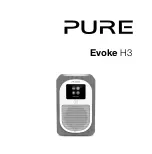
Speaker Installation
Bi-Directional Reentrant
Horn Loudspeaker
PEC CODE: 5331-211
COM CODE: 408185999
MODEL: LU30WBIDI70VH
Issue 3,August 2002
Specifications subject to change without notice.
© 2002 Bogen Communications Inc. All rights reserved.
Part No. 54-2007-0
1
R3 Printed in Korea 0208
Select Code: 70
1
-000-
11
3
Speaker Assembly
The bi-directional speaker must be assembled prior to installation. See Figure
3
on the back of this sheet for speaker assembly
information. Make sure to place the washer/seals where indicated and hand tighten the various components -
do not use pliers
or similar tools.
STEP
1
-
For easier installation, remove the flange (base) from the speak-
er by unscrewing the wing nut while at the same time pressing inwardly on
the wing nut. Place the flange flush with the mounting surface and mark the
location of the three holes with either a marker or chisel. It is important
that the three holes be exactly aligned with the flange, otherwise you might
stress the base or make the connection unsteady (see Figure
1
). Insert 3
wall anchors - see diagrams on the back of this sheet for drilling instruc-
tions and use of anchors. (Use appropriate hardware for your specific
mounting surface.)
NOTE:
Speaker may also be strap-mounted through the slot in flange (base)
using standard
1
/2-inch industrial strapping (not included).
STEP 2 -
After mounting the flange, reattach the speaker to the flange and
aim the speaker for the desired coverage. A 45o downward angle is rec-
ommended, but this may vary depending upon speaker layout. Unless oth-
erwise indicated, do not aim speakers directly at each other or poor paging
intelligibility may occur.
STEP 3 -
Remove the plastic cover to make the electrical connection and
set the tap set control (see Figure 2).
Note:
Use 22 AWG shielded, twisted
pair on all wire runs.
Connect speaker wire shield to the ground (GND) ter-
minal of the amplifier’s output. Carry the ground through all speaker cables
by tying the shields of the speaker cables together in a “daisy chain” fash-
ion.
Do not connect the shield to the speaker itself.
The shield is only
connected at the amplifier end and simply floats.
Connect wires as listed below:
Amplifier Outputs Speaker Connections
70V Terminal
1
COM
Terminal 2
NOTE
: The speaker will also work perfectly well with these connections reversed.
However, reduced low frequency response may result.
STEP 4 -
Adjust the tap set control to the desired setting. See table at right
for tap settings and sound pressure levels for the different horn loudspeak-
ers. Replace the plastic protective cover back over the exposed area.
NOTE:
The two furthermost clockwise settings on the volume control will
produce the same volume.
Figure 2
ELECTRICAL
CONNECTION
TAP SET
CONTROL
TAP
SET
30 WATT HORN
1
110
0.9
2
113
1.9
3
116
3.8
4
119
7.5
5
122
15
6
125
30
7**
125
30
8** Not Used
dBspl*
@ 70V
WATTS
* at four feet on axis
** 7 is the furthest position control switch will turn
Page 1 of 2
Figure 1: Mounting Speaker Base




















